Today, the media, somehow related to portable electronics, it's hard not to meet a statement like "communicators and smart phones wiping out the usual PDAs. Vozozhno, it does so, moreover, that the new models communicators appear almost every week. Nevertheless, in itself, a PDA - the product is very popular and users of PDA while more than smartphones. This is especially important for our country, where the new items (especially if they can work in cellular networks), there are long overdue.
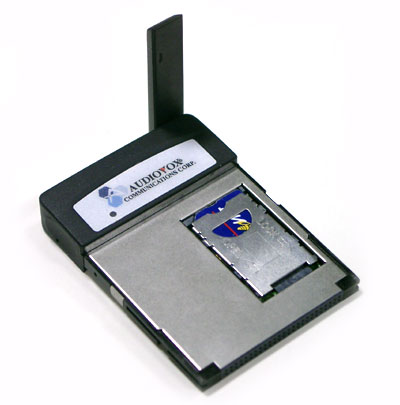 |
| Audiovox RTM-8000 |
Nevertheless, desperately wants to reconcile. Than to carry two pieces of iron, is not it easier to sculpt them into one? To solve this problem, there are GSM / GPRS modules (usually on the cards form factor Compact Flash), which are connected to the handheld. One of these modules - RTM-8000 Audiovox - came to our office for testing. Of course, tastes, all different, but I would never have traded my mobile to this Audiovox. RTM-8000 - a typical example of ruined an excellent idea. IMHO. Outwardly, everything looks good: neat box with a plump instruction manual, the disk itself is a solid card in a transparent plastic cover and handsfree headset with microphone. For work, of course, will need additional software - Dialer from IA Style can be installed from the CD that comes with Included Parts supplies. In addition, the disk can find software for different versions of Windows, which will use the card as a wireless modem. Probably true for laptops. We are also much more interesting, how it will work on a PDA. As a guinea pig used the "average" Pocket PC Mitac MIO 528.
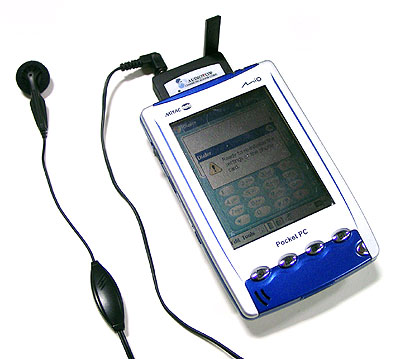 |
| Mitac Mio as a phone |
So, after installing a new program menu appears Dialer. Run, we see on the screen familiar to all owners of mobile phones number keys, plus two additional buttons: start a conversation, end the conversation. The middle place of honor on the volume control. Unfortunately, with a scroll wheel it has nothing to do, so the volume will have to adjust the stylus (or, to ascribe the "volume up", "volume down" to the other buttons on the body). The keys to the figures occupy a lot of space, but in practice dialing finger results in a heroic struggle with the CCP. Painted buttons obviously would not hurt to be a little more.
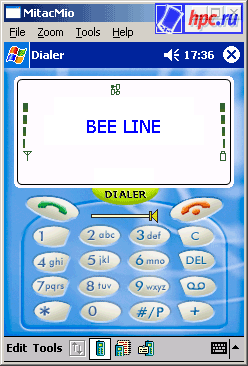 |
| The main screen |
At the top of the screen - a field that performs the function display of a mobile phone. However, useful information here is not very much. Displaying the reception level, battery level Bater, operator logo, and, if access to the GPRS, the icon. It also displays the number from which the incoming call. When calling the top of the screen still flashes an icon with the phone. Unfortunately, as I tried, I could not catch it in a screenshot. If you are unable to answer the call, his number is on the screen. You can poke and call back. It also displays icons sinaliziruyuschie a new voice mail message, a new text message or mailbox is full, the roaming, etc. That is, in fact, all that is available from the main screen.
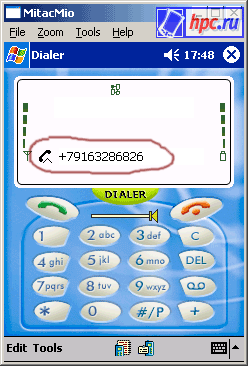 |
| Incoming call |
After just a few minutes of use it appears that the use of RTM-8000 in a phone fun, but inconvenient. For example, I often get a phone call from the list of recently dialed calls, to which almost any modern phone, you can get in one keystroke. Here, such a list, not at all - there are three separate for missed, received, and dialed. The manual says that a long press of a button start the conversation allows you to dial the last number dialed. Well, I do not know how I'm there which is not pressed, but I have nothing to type. Maybe hand curves, but the fact remains. A separate screen is designed to work with a list of contacts on the SIM-card. You can edit, create, delete. Call the selected number in two clicks. Here everything is predictable and easy. Just out of this mode is accessed by three lists of recent calls. Here you can specify one or more numbers to call in an emergency (112 and 911 calls can be made, even if you do not have money in the account or no SIM-card). Next comes a list of "Frequent" - often used numbers. Here you can add any number, but that this list to do and why we need it, I did not understand the instructions and I can not explain. In principle, there is room allocated to numbered positions, and possibly intended for a set of continuously pressing the corresponding number on the keypad. However, Mitac Mio this trick did not work. Recalling that did not work and claimed dialing, last number, the possibility that this bug personally Mitac Mio. Here is a list of contacts stored on SIM-card. Very nice that you can fully use the data from a database of contacts, which is stored on the PDA. Separate strochechkoy - Contacts. Here are just embarrassed that for each phone - a separate entry. That is, if you have the name of Bill Gates has recorded four phone, Dialer'e will be four separate Bill Gates. Three phone Steve Jobs - Three separate Steve Jobs. The last screen is for typing and sending SMS messages. Here, too, can be selected as the recipient of the entries in the SIM-card and the contacts on your PDA. You can even arrange a mass mailing - contacts on SIM cards can be identified all at once, and contact the PDA will need to add a Mailing List on one. I must say that sms sent out very badly. Normally sent only a tenth of messages come "sms" sometimes without the inclusion of the signal. You are removing commercials PDA module from his pocket, and then a dozen new posts.
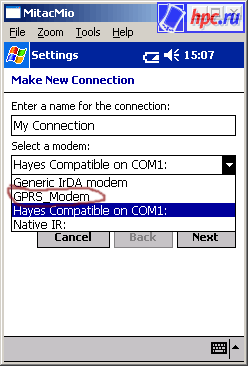 |
| GPRS-modem |
No special software "souvenirs" for setting up and connecting via the GPES not. There is only a shortcut that runs the standard setup dialog network connection. In the list of modems appears GPRS-modem, and use that. In terms of data transmission to the module no claims. I have a few days could not start the GPRS MTS, but I think it is the fault of the operator (GPRS MTS is not yet very reliable). With bilaynovskoy card connected to the third or fourth time, then the connection is stable. All settings are standard initialization string is needed. Theoretically, not needed and addresses DNS-servers, but without them, Mitac Mio refused to open the page. Much difference in speed compared with a bunch of Mio + Ericsson R520m was observed. GPRS as GPRS, 2-3 KB per second in the city center during working hours. But the "phone" features leave much to be desired. Reception is much worse than any cell phone in our office (there is also Ericsson'y and Motorol'y and Siemens'y, and LG).Acceptance of our so-so, but all cell still keep the network and allows you to talk, albeit sometimes with audio "artifacts". Audiovox network all the time lost from time to time with the inclusion of an error in the authorization network. After the network lost (released in off-line), not trying to get her back, as well as hanging useless appendage. And in general, creates a feeling of great "glyuchnosti. For example, the program has an option that allows you to leave the PDA on, even if the standard shut after a period of inactivity. Indeed, if the PDA off, the user will miss all incoming calls (and sms not only neglect, but do not always come). All would be great, but this option does not work. PDAs (Mitac Mio, at least), how to turn off both on and off.
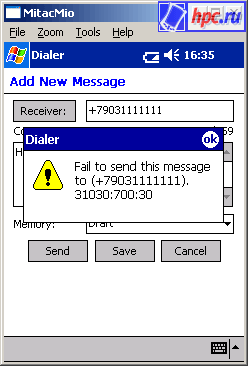 |
| And so almost always! (In tests, of course, used the existing number) |
SMS-messages, as already mentioned, the "go" with difficulty. Reinstall the software, changed the SIM-card (and cameraman) - still goes well if one out of ten. In Russian with sites of MTS and the Bee Line and the phone accepts, too, to send ships, but in Unicode. Most new mobile phone models such communications understand, but with the "old men" like the Siemens C25, S25 and other models of the same model years is better to use transliteration. But to the Handsfree any claims. Moderately clear and clean sound with headphones porollonovoy nasadochkoy (to ear does not hurt). High volume (the program may sound, and "extinguish"). The two sides said that they hear me very clearly, so that the microphone with their functions to cope. Buttons on the microphone you can answer an incoming call or end the conversation. In general, I want to confirm my conclusion - the idea is excellent, but too many glitches (although, certainly, the software is obnovltsya and glitches will be corrected). As a phone I'd use the RTM-8000 does not become (even more so that even in standby mode, it puts a fully charged battery for about half or two hours. The talk is literally seen as an indicator of battery level creeps down. But as a portable skorostonogo (relatively) a modem for GPRS networks, the device is well suited. Energy spent less, and glitches are not so much.'s only GPRS is far from universal even in Europe.
Opinion seller
Company Mobile advice, "the only dealer in Moscow RTM-8000, after reading this article, decided to express their own opinions about the usability of the device. I am pleased to publish this opinion - we are interested in all views. Here is the text sent to us without any changes and comments. Why use this device? As a phone? Not quite true. Still, it is primarily a modem that works in the network GSM / GPRS. Data module can be used as a phone, but it is just an additional feature and judge the merits and demerits of the module (Fe) based on the experience (and not entirely successful) testing program IDialer (software) would be extremely rash. Obviously, the "average" PDA is not quite working correctly with the specified module, and the program IDialer - not only in its class. ("But you never know in Brazil pedro!" - Exclaimed to Don Rosa). Experience in operating the module with "nizhestatisticheskim" PDA Cassiopeia E-115 gives the following results: Catering. Setting the prohibition of transfer of the CPC in standby mode (suspend mode) works! Energy consumption of the module during a call does not result in rapid discharge batteries PDA, and standby consumption is negligible. Speed dialing. This feature is not implemented the program IDialer. Last number redial. To implement this feature, you must press and hold the call button. The implementation of this operation must be performed very precisely, because "Bounce" when you defined the program as a short-term depression and lead to an attempt to dial the number, dialed the phone. This raises the suspicion of leftism of the program, and the reason - shaking hands.Re-register on the network. In this regard, surely noticed that there are difficulties when registering to GSM network after the loss of the network. Obviously, the procedure is to search for and register the network module is implemented is not entirely correct. A bit of personal experience. From my point of view, the program was designed as an auxiliary IDialer (!!!) product. It is obvious that use 2 SIM cards for data transfer and making phone calls for most users PDA is a luxury, so the producers of the module made it possible to make and answer incoming calls with a minimum investment of time and effort. Thus, this device is an analog terminal GSM, while the CPC is used as the user interface (dialer, headset, power supply and everything else). A nice feature of this "phone" is the ability to programmatically change not only the front panel, but also options for audio signals, the location of buttons, their shapes, to improve the functionality of your device. Now the main thing - the modem. Support module standard and extended set of AT commands for data, voice and fax, with phone book and SMS makes it compatible with more software developed for PDAs and PCs, as well as without much difficulty to create new software products. The module opens up new prospects for integration of your PDA or PC in your mobile business. Especially it is necessary to note the possibility to send short messages via GPRS. On the phone. It should be noted that the device requires no complicated setup to work as a phone. Simply insert it into the slot of your PDA and a few seconds you can answer calls using the headset. Availability time of the module to receive calls is comparable to the time of registration in the GSM network standard telephone. IDialer program is used to provide a graphical user interface and access to additional services (SMS, phone book, etc.), thereby compensating for any inconvenience the lack of a SIM card from your phone. The LED on the front side shows the current state of the module. In case of detection and successful registration in the network indicator flashes green. The red flashes indicates the absence of a network or the impossibility of registration. When using the PC laptop (via an adapter CF-PCMCIA) connection to GSM network by default is not carried out. In this case, decreases the time a connection via GPRS because of lack of phase disconnect from the network of GSM. Accordingly, when a connection via the data GSM, shall be registered in the network and the further connection. PDA these procedures are performed by selecting the menu item in the program IDialer. The authors, translation:











